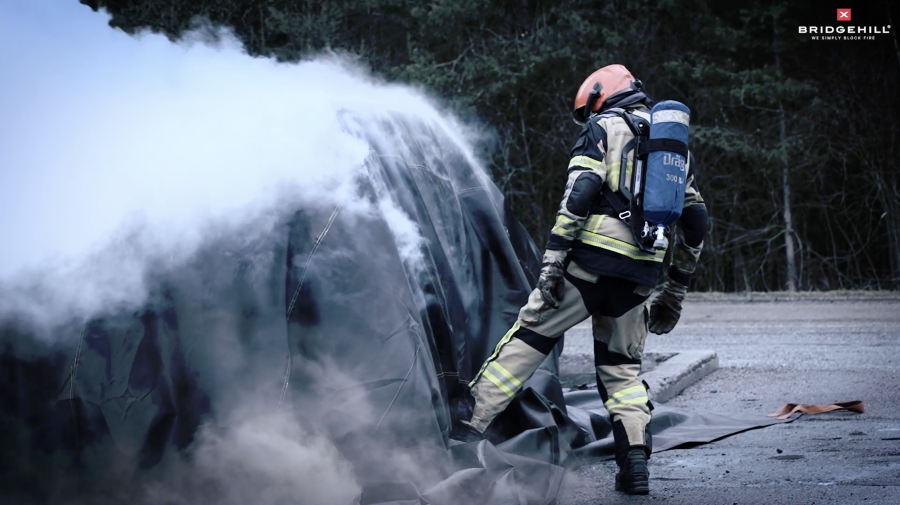Over the past five or so years, it has become increasingly obvious that the seaborne carriage of electric vehicles (EVs) using lithium-ion batteries can pose a serious risk in the event of an accident.
The main hazard is related to the risk of thermal runaway, which can cause fires or explosions if the Li-ion battery is punctured, damaged or exposed to high temperatures. As well as emitting smoke and toxic gases, Li-ion battery fires are feared for their ferocious speed of spread and their longevity: even a fire that appears to have been extinguished can reignite days, or even weeks, afterwards.
Opinions on the level of risk remain mixed, though. For example, the recently published findings by the EU-funded LASH FIRE project (see Ship & Boat International May/June 2023, page 19) give the impression that containing and suppressing EV fires may not be significantly more difficult than tackling internal combustion engine vehicle (ICEV) fires at sea.
Additionally, last year, the Danish Institute of Fire and Security Technology (DBI) reassured the maritime sector: “Fires in electric cars on board ferries are manageable and not something we need to fear…with the correct firefighting technologies on board, the correct training of the crew and well-coordinated collaboration with the onshore emergency services, electric cars should not pose a safety problem in ferry traffic” (see Ship & Boat International January/February 2023, pages 34-35).
Not everyone is as convinced, though. While supportive of LASH FIRE, Tony in’t Hout, director at maritime consultancy and training provider Stream Marine Technical, reserves some scepticism regarding the project’s findings, following the tests the LASH FIRE partners conducted on a simulated vessel deck. “These tests weren’t conducted in a realistic environment,” in’t Hout tells Ship & Boat International. “They need to be held on an actual vessel deck, with its limited space and ventilation, and with the EVs actually parked side by side as they would be during a cruise or ferry trip.”
A huge part of the problem, he adds, is that shipping companies aren’t just lagging behind when it comes to proposing solutions: they’re struggling to comprehend the multiple risk factors at all. “Li-ion batteries aren’t just a ‘one-stop shop’,” he says. “There are different types of Li-ion batteries for fixed onboard systems, cars and e-scooters, mobility scooters, laptops, smartphones and even e-cigarettes.” Each of these items presents its own level of risk, and demands its own ‘best practice’ for fire containment and suppression – but these differences are still failing to make it to the debate, he believes.
“The industry is not prepared at all,” in’t Hout warns. “This is why the airline and container shipping sectors are extremely reluctant to deal with EVs. Insurers are also becoming more concerned about superyacht fires caused by electric tender battery failures, which can easily lead to loss of sections of the vessel, if not loss of the vessel itself.
“Li-ion battery fires may be rarer than internal combustion engine fires, but they still take longer and more effort to put out when they do occur. An affected EV needs to be fully submerged, but how do you do that on a fast ferry? People think you can just dump tonnes of water over it, but it’s not practical.”
In in’t Hout’s opinion, more testing is the way forward, focusing on realistic onboard environments and a more diverse range of Li-ion battery types. However, he concedes: “Who’s going to pay for it?” While awareness of the risks has picked up in recent years, EV fire safety assessments remain low on the list of governmental funding priorities.
Unfortunately, he adds, cost may be causing the marine industry to downplay the risk. For example, he explains: “We need to see a big investment in PPE for firefighters tackling Li-ion fires. These fires will require PPE that can protect the wearer for five or six hours of containment…whereas some current equipment, designed to tackle traditionally fuelled vehicle fires, is designed for 30-minute operations.”
He also sees a need for naval architects to rethink vessel design, which may add expense to new orders. Vessels are structurally designed for conventional fires, but not to protect the ship and its equipment from anything related to Li-ion fires, in’t Hout says. Addressing these factors will be necessary before the industry can adopt a genuinely optimistic outlook, he opines, concluding: “There’s no one solution: that’s the problem.”






